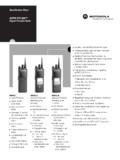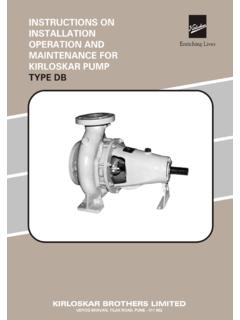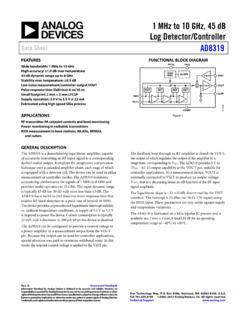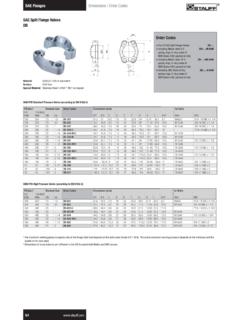Transcription of 1 MHz to 4 GHz, 80 dB Logarithmic …
1 1 MHz to 4 GHz, 80 db logarithmic Detector/ controller Data Sheet ADL5513 Rev. A Document Feedback Information furnished by analog devices is believed to be accurate and reliable. However, no responsibility is assumed by analog devices for its use, nor for any infringements of patents or other rights of third parties that may result from its use. Specifications subject to change without notice. No license is granted by implication or otherwise under any patent or patent rights of analog devices . Trademarks and registered trademarks are the property of their respective owners. One Technology Way, Box 9106, Norwood, MA 02062-9106, Tel: 2008 2017 analog devices , Inc. All rights reserved. Technical Support FEATURES Wide bandwidth: 1 MHz to 4 GHz 80 dB dynamic range ( 3 dB) Constant dynamic range over frequency Stability over 40oC to +85oC temperature range: dB Operating temperature range: 40oC to +125oC Sensitivity: 70 dBm Low noise measurement/ controller output (VOUT) Pulse response time: 21 ns/20 ns (fall/rise) Single-supply operation: V to V at 31 mA Power-down feature.
2 1 mW at 5 V Small footprint LFCSP Fabricated using high speed SiGe process APPLICATIONS RF transmitter power amplifier linearization and gain/power control Power monitoring in radio link transmitters RSSI measurement in base stations, WLAN, WiMAX, RADAR FUNCTIONAL BLOCK DIAGRAM 2143 IVIVDETDETDETDETDETSLOPECONTROLGAINBIASB AND GAPREFERENCE1211109131415168765 ADL5513 VOUTVSETCOMMTADJINHIINLOVPOSVPOSNCNCCLPF NCNCNCNCNC07514-001 Figure 1. GENERAL DESCRIPTION The ADL5513 is a demodulating Logarithmic amplifier, capable of accurately converting an RF input signal to a corresponding decibel-scaled output. It employs the progressive compression technique over a cascaded amplifier chain, each stage of which is equipped with a detector cell. The device can be used in either measurement or controller modes. The ADL5513 maintains accurate log conformance for signals up to 4 GHz.
3 The input dynamic range is typically 80 dB (referred to 50 ) with error less than 3 dB and 74 dB with error less than 1 dB. The ADL5513 has 20 ns response time that enables RF burst detection to a pulse rate of beyond 50 MHz. The device provides unprecedented Logarithmic intercept stability vs. ambient temperature conditions. A supply of V to V is required to power the device. Current consumption is 31 mA, and it decreases to 200 A when the device is disabled. The ADL5513 can be configured to provide a control voltage to a power amplifier or a measurement output from the VOUT pin. Because the output can be used for controller applications, special attention has been paid to minimize wideband noise. In this mode, the setpoint control voltage is applied to the VSET pin. The feedback loop through an RF amplifier is closed via VOUT, the output of which regulates the amplifier output to a magni-tude corresponding to VSET.
4 The ADL5513 provides 0 V to (VPOS V) output capability at the VOUT pin, suitable for controller applications. As a measurement device, VOUT is externally connected to VSET to produce an output voltage, VOUT, that increases linear-in-dB with RF input signal amplitude. The Logarithmic slope is 21 mV/dB, determined by the VSET interface. The intercept is 88 dBm (referred to 50 , conti-nuous wave input, 900 MHz) using the INHI input. These parameters are very stable against supply and temperature variations. The ADL5513 is fabricated on a SiGe bipolar IC process and is available in a 3 mm 3 mm, 16-lead LFCSP package for the 40 C to +125 C operating temperature range. A fully populated evaluation board is available. ADL5513 Data Sheet Rev. A | Page 2 of 25 TABLE OF CONTENTS Features .. 1 Applications .. 1 Functional Block Diagram.
5 1 General Description .. 1 Revision History .. 2 Specifications .. 3 Absolute Maximum Ratings .. 7 ESD Caution .. 7 Pin Configuration and Function Descriptions .. 8 Typical Performance Characteristics .. 9 Theory of Operation .. 13 Applications Information .. 14 Basic Connections .. 14 Input Signal Coupling .. 14 Output Filtering .. 14 Output Interface .. 15 Setpoint Interface .. 15 Description of Characterization .. 15 Error Calculations .. 16 Adjusting Accuracy Through Choice of Calibration Points 16 Temperature Compensation of Output Voltage .. 17 Device Calibration .. 18 Power-Down Functionality .. 18 Measurement Mode .. 19 Setting the Output Slope in Measurement Mode .. 19 controller Mode .. 20 Constant Power Operation .. 20 Increasing the Dynamic Range of the ADL5513 .. 22 Evaluation Board .. 23 Outline Dimensions .. 25 Ordering Guide.
6 25 REVISION HISTORY 8/2017 Rev. 0 to Rev. A Change to Figure 2 .. 8 Updated Outline Dimensions .. 25 Changes to Ordering Guide .. 25 10/2008 Revision 0: Initial Version Data Sheet ADL5513 Rev. A | Page 3 of 25 SPECIFICATIONS VS = 5 V, TA = 25 C, Z0 = 50 , Pin INHI and Pin INLO are ac-coupled, continuous wave (CW) input, single-ended input drive, VOUT tied to VSET, error referred to best-fit line (linear regression 20 to 40 dBm), unless otherwise noted. (Temperature adjust voltage optimized for 85 C.) Table 1. Parameter Conditions Min Typ Max Unit OVERALL FUNCTION Maximum Input Frequency 1 4000 MHz FREQUENCY = 100 MHz Output Voltage: High Power Input PIN = 10 dBm V Output Voltage: Low Power Input PIN = 50 dBm V dB Dynamic Range 75 dB dB Dynamic Range 64 dB dB Dynamic Range 58 dB Maximum Input Level, dB 6 dBm Minimum Input Level, dB 58 dBm Deviation at TA = 25 C PIN = 10 dBm dB PIN = 30 dBm dB PIN = 50 dBm dB Deviation vs.
7 Temperature Deviation from output at TA = 25 C 25 C < TA < 85 C; PIN = 10 dBm + dB 40 C < TA < +25 C; PIN = 10 dBm + dB 25 C < TA < 125 C; PIN = 10 dBm dB 25 C < TA < 85 C; PIN = 30 dBm + dB 40 C < TA < +25 C; PIN = 30 dBm dB 25 C < TA < 125 C; PIN = 30 dBm + dB +25 C < TA < +85 C; PIN = 50 dBm + dB 40 C < TA < +25 C; PIN = 50 dBm + dB 25 C < TA < 125 C; PIN = 50 dBm + dB Logarithmic Slope 21 mV/dB Logarithmic Intercept 87 dBm Input Impedance k /pF FREQUENCY = 900 MHz Output Voltage: High Power Input PIN = 10 dBm V Output Voltage: Low Power Input PIN = 50 dBm V dB Dynamic Range 76 dB dB Dynamic Range 70 dB dB Dynamic Range 68 dB Maximum Input Level, dB 8 dBm Minimum Input Level, dB 62 dBm Deviation at TA = 25 C PIN = 10 dBm dB PIN = 30 dBm dB PIN = 50 dBm dB Deviation vs.
8 Temperature Deviation from output at TA = 25 C 25 C < TA < 85 C; PIN = 10 dBm + dB 40 C < TA < +25 C; PIN = 10 dBm + dB 25 C < TA < 125 C; PIN = 10 dBm + dB 25 C < TA < 85 C; PIN = 30 dBm + dB 40 C < TA < +25 C; PIN = 30 dBm + dB 25 C < TA < 125 C; PIN = 30 dBm dB 25 C < TA < 85 C; PIN = 50 dBm + dB 40 C < TA < +25 C; PIN = 50 dBm + dB 25 C < TA < 125 C; PIN = 50 dBm + dB ADL5513 Data Sheet Rev. A | Page 4 of 25 Parameter Conditions Min Typ Max Unit Logarithmic Slope 21 mV/dB Logarithmic Intercept 88 dBm Input Impedance k /pF FREQUENCY = 1900 MHz Output Voltage: High Power Input PIN = 10 dBm V Output Voltage: Low Power Input PIN = 50 dBm V dB Dynamic Range 75 dB dB Dynamic Range 70 dB dB Dynamic Range 68 dB Maximum Input Level, dB 8 dBm Minimum Input Level, dB 62 dBm Deviation at TA = 25 C PIN = 10 dBm dB PIN = 30 dBm dB PIN = 50 dBm dB Deviation vs.
9 Temperature Deviation from output at TA = 25 C 25 C < TA < 85 C; PIN = 10 dBm + dB 40 C < TA < +25 C; PIN = 10 dBm + dB 25 C < TA < 125 C; PIN = 10 dBm dB 25 C < TA < 85 C; PIN = 30 dBm + dB 40 C < TA < +25 C; PIN = 30 dBm + dB 25 C < TA < 125 C; PIN = 30 dBm dB 25 C < TA < 85 C; PIN = 50 dBm + dB 40 C < TA < +25 C; PIN = 50 dBm + dB 25 C < TA < 125 C; PIN = 50 dBm + dB Logarithmic Slope 21 mV/dB Logarithmic Intercept 88 dBm Input Impedance k /pF FREQUENCY = 2140 MHz Output Voltage: High Power Input PIN = 10 dBm V Output Voltage: Low Power Input PIN = 50 dBm V dB Dynamic Range 77 dB dB Dynamic Range 70 dB dB Dynamic Range 66 dB Maximum Input Level, dB 8 dBm Minimum Input Level, dB 62 dBm Deviation at TA = 25 C PIN = 10 dBm dB PIN = 30 dBm dB PIN = 50 dBm dB Deviation vs.
10 Temperature Deviation from output at TA = 25 C 25 C < TA < 85 C; PIN = 10 dBm dB 40 C < TA < +25 C; PIN = 10 dBm + dB 25 C < TA < 125 C; PIN = 10 dBm + dB 25 C < TA < 85 C; PIN = 30 dBm + dB 40 C < TA < +25 C; PIN = 30 dBm + dB 25 C < TA < 125 C; PIN = 30 dBm dB 25 C < TA < 85 C; PIN = 50 dBm + dB 40 C < TA < +25 C; PIN = 50 dBm + dB 25 C < TA < 125 C; PIN = 50 dBm + dB Logarithmic Slope 21 mV/dB Logarithmic Intercept 89 dBm Input Impedance k /pF Data Sheet ADL5513 Rev. A | Page 5 of 25 Parameter Conditions Min Typ Max Unit FREQUENCY = 2600 MHz Output Voltage: High Power Input PIN = 10 dBm V Output Voltage: Low Power Input PIN = 50 dBm V dB Dynamic Range 80 dB dB Dynamic Range 74 dB dB Dynamic Range 69 dB Maximum Input Level, dB 7 dBm Minimum Input Level, dB 67 dBm Deviation at TA = 25 C PIN = 10 dBm dB PIN = 30 dBm dB PIN = 50 dBm dB Deviation vs.


















